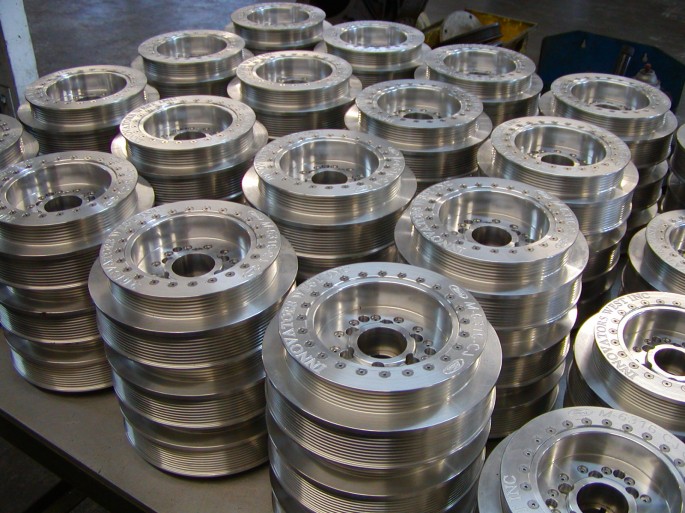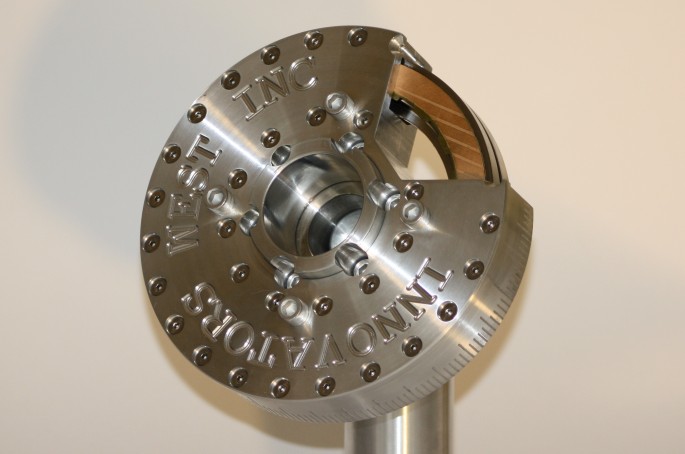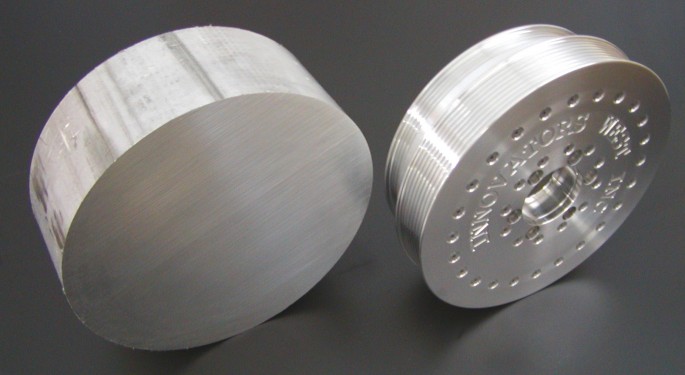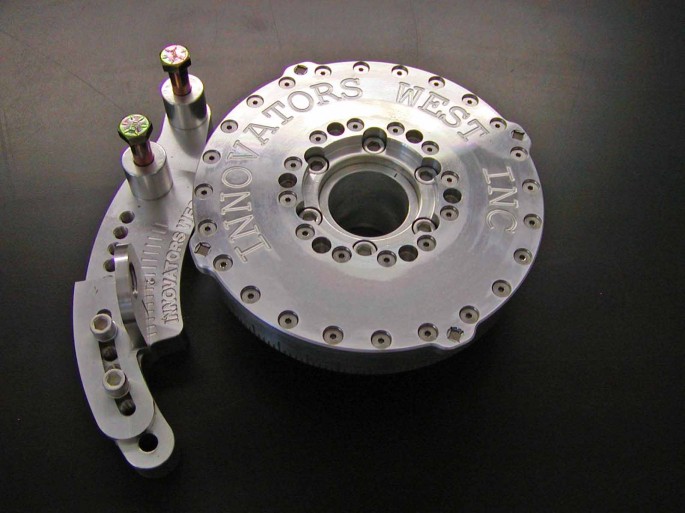You know that big spinning thing on the front of your crankshaft? The one that holds the pulley for your fan belt? Some people refer to them as balancers, and others call them dampeners or dampers. The truth is all three names are correct, sort of. For the sake of argument, lets say the name doesn’t matter. Then what the heck is that thing really doing? Well, with the help of Chris and Brad at Innovators West we’re going to tell you right here in Harmonic Balancer 101, because we’re pretty sure we’ve got some info here you didn’t know about and really should.
The average hot rodder has undoubtedly heard the term Externally Balanced, and Internally Balanced, with regards to balancers, but I know that despite knowing that they are different, a lot of folks don’t know how to tell the difference. And with different sizes of balancers on engines of the same family and sometimes displacement, things can get confusing in a hurry. Unfortunately confusing parts sometimes become the ones that people just take for granted and choose not to give the attention they deserve. Considering the fact that your balancer choice can determine whether or not your crankshaft will live a long happy life, you should know a few things before buying one for your engine combination.
Dampers, or balancers are unique to different engines. Their diameter is often directly related to stroke, but total engine rpm and the rate at which the engine is intended to rev also come into play. For example, a high winding engine that is being used for drag racing may in fact have a smaller diameter balancer than that same high winding engine being used for road racing. In theory, the small block on the drag strip is accelerating at a more rapid rate, even if ultimate engine rpm is the same, and therefore has less time to experience dangerous harmonics and so the smaller balancer may be sufficient.
And while we’ve never tested it personally, we have heard several stories of engines being run on the dyno with no damper and seeing less horsepower than the same engine with the damper installed. So, we know they will save your engine from costly damage, but they also may actually help it make more power.
We asked the guys at Innovators West a few questions to help us all understand what’s really going on down there, and here are their responses and more information you need to know.
FOR MORE INFORMATION ON INNOVATORS WEST BALANCERS USE THIS LINK
Is it a Balancer or Damper? Are they two different things? The differences in names often confuse people, so what’s the right terminology?
The two terms, damper and balancer, are often confused and are often used interchangeably. The function of a damper is to absorb and dampen the vibrations created by the engine from the firing pulses of the combustion process.
A balancer on the other hand is used in conjunction with the crankshaft and flywheel to balance the rotating assembly of the motor. While all of our harmonic balancers are dampers, the correct use of the word would only be technically correct for those used on externally balanced engines that have an external bolt on weight. Regardless of the technical aspect, since everyone calls them “balancers” we do as well.
What are they actually doing, and why?
The damper is used to reduce and if at all possible eliminate the vibration and harmonic energy created by the firing pulses of the engine. The dampers also often incorporate a bolt pattern on the front for driving accessory pulleys. Many of the late model engines have serpentine belt grooves machined directly into the outside of the damper for driving accessories, rather than using bolt on pulleys. Innovators West specializes in larger overdriven serpentine dampers for late model supercharged engines.
By increasing the size of the crankshaft pulley, and damper in this case, you speed up the supercharger, increasing boost and airflow, which means more horsepower. Plus you gain the added confidence of having a damper that you know will live at high rpm, rather than coming apart and tearing up everything under the hood or worse.
Without a balancer or damper, the harmonic forces that the crankshaft is seeing would quickly damage the bearings in the short block of an engine. In some combinations this damage would be more severe and happen quicker, but regardless that damage is going to occur. And keep in mind that a damper that is not functioning properly may cause the same or more damage.
How are dampers doing what they do? What are the differences between the way an Innovators West design works, in comparison to other options like the TCI Rattler, Fluidamper, etc?
A damper will have an inertia weight that will counter act the vibration and harmonic energy that is inputted into the damper.
A factory style damper (and some aftermarket designs as well) is often an elastomeric style of damper where the outer ring of the damper is bonded to the center of the damper with rubber (some aftermarket dampers use press fit rubber o-rings versus bonded rubber). The damper is tuned by way of the durometer of the rubber, the inertia weight of the outer ring and the amount of rubber used. The limitations of this style of damper is that the bonded rubber only has so much movement that it can make before the damper stops moving (and dampening) and the outer inertia ring will rebound in the opposite direction or the rubber will shear (factory style dampers often fail and can physically separate).
Physical separation can be incredibly dangerous. We’ve seen a damper come off an engine on the dyno, and while it looked like it was sitting still on the floor it was really doing about 7000 rpm, and when the steel finally did get some traction it decided it was going for a ride around the dyno cell that likely would have hurt someone bad, and could most certainly have killed them. These things are heavy, and when they start flying around bad things happen.
Another type of damper is the viscous damper. These dampers use a thick fluid (often times silicone fluid) combined with an inertia weight. The movement of the inertia weight shears the fluid. The shearing action of the fluid provides the absorption of the harmonics and vibrations.
Innovators West dampers are friction style dampers. We can tune our dampers by varying the weight/size of the internal inertia rings, the spring loaded pressure of the clutch discs and the style and size of the discs themselves. We find that clutch pack design of our dampers does not limit the movement of the inertia rings as it does in the bonded rubber style dampers. This allows for a wider tuning window in our experience. The clutch pack is allowed to spin as much or as little as needed to transfer the incoming energy into heat (via the friction) and is dissipated through the aluminum case.
What are the most common misconceptions about balancers/dampers?
The biggest misconception is that the damper is a cure all for engine breakage. Even the best damper will not be able to save an engine from severe detonation due to a missed tuneup or from overpowering understrength (often factory) parts.
While an engine being out of balance, or having severe harmonics that are not being address by a damper, can quickly damage it, detonation is probably the worst bearing killer of them all. Like the rest of the parts inside your engine, the damper is just one component in the puzzle, and choosing the right one can be the difference between success and failure.
What does a hot rodder or racer need to know about their engine combination and use in order to choose the right balancer?
The biggest thing that a customer needs to determine is the engine use. Is this going to be a daily driver, street/strip or race engine? Each application has their different requirements. We have dampers that cover all of those applications but we may try and move a customer into different dampers and/or options depending on how the engine will be used.
Choosing the wrong damper may not prove to be a problem in the short term, but it most certainly won’t provide the optimal performance you are looking for from your high performance engine, and in the long run could cost much more than a high quality damper. While Innovators West dampers are of the friction variety, it’s not just the method of harmonics and vibration management that matter to performance. The overall diameter of the damper can have a real effect on performance, both with regards to managing those dynamic forces, and with regards to the acceleration capability of the engine. Just like putting a big diameter heavy flywheel will change the way an engine runs in comparison to a small diameter lightweight flywheel, the diameter of the balancer can also effect the rate at which the engine will rev.
If the size of the damper matters, and can effect performance, then the material your balancer is made from must matter. After all Steel would be much heavier than Aluminum. Which on is better, or does it matter?
We choose to make our damper bodies from 6061 Aluminum. This allows us to reduce the overall weight of the damper with minimal effect to the dampening ability. Any time you can reduce the weight of items being spun by the crankshaft, less power will be consumed driving the items and more power will be seen at the crank.
What questions does a person looking for a new damper need to be prepared to answer? What information really matters?
In order to properly spec a damper for a particular engine, there are several things that need to be known, but each and every one is pretty simple to figure out.
The intended use of the engine is one of the most important things that needs to be considered when choosing a damper for your engine. A street strip small block Chevrolet is going to have different requirements than a 460 Ford in a big 1 ton dually. Both the diameter and style or settings of the damping system will change depending on the application.
In addition to the intended use of the engine, Innovators West asks for engine cubic inches, stroke, rpm range, and what if any power adders are going to be used. This last on is especially important because a belt driven supercharger puts a much different load on the damper and the front of the crankshaft than does a nitrous of turbo charged package. With that said, nitrous and turbos also put a much different load on the crankshaft and damper. Power adders do matter. It’s better to choose a damper that will work with your turbo or nitrous combo once you add them to your combination down the road, rather than to choose a damper designed for a naturally aspirated combination only to put a 12-71 blower on it for the ride home.
What are the most common mistakes people make when choosing a damper for their engine?
Ordering what they saw on the internet versus getting a proper recommendation. Just because the part says that it fits your engine, doesn’t mean it is the RIGHT one for your engine. Bolting on vs doing the best job, are two different things.
Ordering too small (or too big) of a damper is also a common mistake. As we stated above, size matters. Choosing the right diameter damper will not only increase the longevity of your engine, but also it’s potential to make power.
What are the most common mistakes people make when installing a damper for their engine?
The number one mistake is not using anti-seize on the snout of the crankshaft. The damper is a tight fit, and not using anti-seize dramatically increases the chances galling, and of having problems removing the damper at a later date, or more importantly damaging the snout of the crankshaft during installation.
Not using the proper installation tools is just as bad, maybe even worse, than choosing the wrong damper. A block of wood and a hammer, while occasionally effective, is a sure way to beat the thrust bearing surface to death and cause even more damage inside your engine. If you don’t own the proper tool, buy or rent one. They are cheap insurance and will make life much easier during the installation process.
The damper is designed for an interference fit. How much interference is determined by the finished outside diameter of the crankshaft snout, and the finished inside diameter of the damper. Too little interference and you run the chance of the balancer becoming loose and therefore far less effective. If the fit is too tight, severe damage can result inside the damper and on the snout of the crankshaft.
If you aren’t familiar with Innovators West, know that Larry and I chose them for the world’s quickest street car S10 project, and that they are some of the finest machinists in the country. Their parts work, they can and will customize them to any spec you require, and they will arrive when promised. Our particular damper on the 620 cubic inch Proline Racing Engine was a pretty big beast, and Innovators West customized it for us with a complete built in flying magnet crank trigger system. Think of it as an MSD Crank trigger wheel being built right into the front of the damper, rather than having a bolt on wheel.
What is quite possibly the best thing about Innovators west is their interest and ability to make the weird stuff too. You name it, they’ll help make it a reality, so when you call and ask about a 1937 Packard damper with a 60-2 trigger wheel, they’ll smile and say “Send us some more info”, and then the elves will start working.
And guys in the know use them. Here is a list of just a few of the famous people that are using them. Read the names, cause they are the big boys.
Larry Larson – Drag Week Super Star, Brad Waddle – IHRA Pro Stock, Bill Glidden – NHRA Pro Mod, Jon Kaase (Engine Masters & Customer Engines), Tony Bischoff (Engine Masters & Customer Engines), Tom Bailey – Drag Week Unlimited, Steve Morris Engines – Personal drag radial woodie wagon & Customer Engines, Charlie Booze Jr. – NMRA Hot Street, Shane Stymiest – NMRA Coyote Stock, Frank Aragona – NHRA Comp Eliminator
FOR MORE INFORMATION ON INNOVATORS WEST BALANCERS USE THIS LINK


























Quite interesting!
Heck, just sent them an e-mail for a quote for one on the OHC Pontiac 250 L6.
I’m going to do the same for my LSR V6!
Good informative advert.
Looks like a less expensive copy of a pre-war Rolls-Royce damper. Just a lot easier to rebuild!